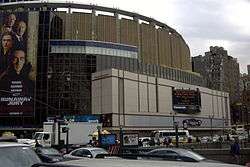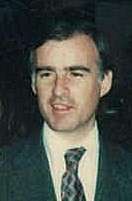1976 Democratic National Convention
|
1976 presidential election | |
|
Nominees Carter and Mondale | |
| Convention | |
|---|---|
| Date(s) | July 12–15, 1976 |
| City | New York City |
| Venue | Madison Square Garden |
| Candidates | |
| Presidential nominee | Jimmy Carter of Georgia |
| Vice Presidential nominee | Walter Mondale of Minnesota |

The 1976 Democratic National Convention met at Madison Square Garden in New York City, from July 12 to July 15, 1976. The assembled United States Democratic Party delegates at the convention nominated former Governor Jimmy Carter of Georgia for President and Senator Walter Mondale of Minnesota for Vice President. John Glenn and Barbara Jordan gave the keynote addresses. Jordan's keynote address made her the first African-American woman to deliver the keynote address at a Democratic National Convention. It was listed as #5 in American Rhetoric's Top 100 Speeches of the 20th Century (listed by rank).[1] The convention was the first in New York City since the 103-ballot 1924 convention.
By the time the convention opened Carter already had more than enough delegates to clinch the nomination, and so the major emphasis at the convention was to create an appearance of party unity, which had been lacking in the 1968 and 1972 Democratic Conventions. Carter easily won the nomination on the first ballot; he then chose Mondale, a liberal and a protégé of Hubert Humphrey, as his running mate.
The Carter-Mondale ticket went on to win the 1976 presidential election on November 2.
The convention is also notable for the fact that congresswoman Lindy Boggs, who presided over it, thus became the first woman to preside over a national political convention.[2]
The Business of the convention
The primary business of the convention is to nominate the party's candidates for president and vice president and draft a platform for them to run on.
Platform
The Democrats' 1976 platform called for continued price controls on natural gas, a policy which had caused dwindling domestic natural gas reserves since 1974 and which President Gerald Ford was asking to rescind.[3] The platform stated: "Those now pressing to turn natural-gas price regulation over to OPEC, while arguing the rhetoric of so-called deregulation, must not prevail.
The Presidential vote tally
The following people had their names placed in nomination.
The tally at the convention was:[4]
| Democratic National Convention Presidential nominee vote, 1976[5] | |||||
|---|---|---|---|---|---|
| Candidate | Votes | Percentage | |||
| Jimmy Carter | 2,239 | 74.39% | |||
| Mo Udall | 330 | 10.96% | |||
| Jerry Brown | 301 | 10.00% | |||
| George Wallace | 57 | 1.89% | |||
| Ellen McCormack | 22 | 0.73% | |||
| Frank Church | 19 | 0.63% | |||
| Hubert Humphrey | 10 | 0.33% | |||
| Henry M. Jackson | 10 | 0.33% | |||
| Fred R. Harris | 9 | 0.30% | |||
| Milton Shapp | 2 | 0.07% | |||
| Robert Byrd | 2 | 0.07% | |||
| Hugh Carey, César Chávez, Leon Jaworski, Barbara Jordan, Ted Kennedy, George McGovern, Edmund Muskie, Jennings Randolph and Fred Stover | 1 vote each | 0.03% each | |||
| Totals | 3,010 | 100.00% | |||
Vice-presidential nomination
According to Jimmy Carter,[6] his top choices for Vice Presidency were: Walter Mondale, Edmund Muskie, Frank Church, Adlai Stevenson III, John Glenn, and Henry M. Jackson. He selected Mondale.
The vice presidential tally, in part, was:
- Walter Mondale 2837
- Speaker of the House Carl Albert 36
- Ronald Dellums 20
- Fritz Efaw 12
- Barbara Jordan 17
- Others 53
In his acceptance speech, Mondale diverted from his printed text which echoed John F. Kennedy's call to "get the country moving again;" Mondale instead said, "Let's get this government moving again!"[7]
See also
References
- ↑ Michael E. Eidenmuller (2009-02-13). "Top 100 Speeches of the 20th Century by Rank". American Rhetoric. Retrieved 2015-10-27.
- ↑ "Former Congresswoman and Ambassador Lindy Boggs Dies at 97 - ABC News". Abcnews.go.com. 2013-07-27. Retrieved 2015-04-15.
- ↑ Frum, David (2000). How We Got Here: The '70s. New York, New York: Basic Books. p. 322. ISBN 0-465-04195-7.
- ↑ Our Campaigns - US President - D Convention Race - Jul 12, 1976
- ↑ http://www.ourcampaigns.com/RaceDetail.html?RaceID=57992
- ↑ Virtual Tour: Race to the White House
- ↑ Frum, David (2000). How We Got Here: The '70s. New York, New York: Basic Books. p. 301. ISBN 0-465-04195-7.
External links
- Democratic Party Platform of 1976 at The American Presidency Project
- Carter Acceptance Speech at The American Presidency Project
- Text and audio of Barbara Jordan's keynote address
- List of members from various state delegations to convention
| Wikimedia Commons has media related to 1976 Democratic National Convention. |
| Preceded by 1972 |
Democratic National Conventions | Succeeded by 1980 |




